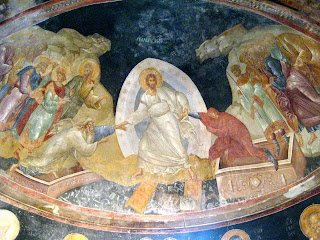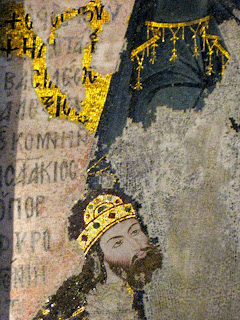 |
Thanksgiving dinner for twelve in Istanbul. |
Thursday, November 25, 2010
Tuesday, November 23, 2010
Turkey for Thanksgiving
Yesterday, ten folks arrived in Istanbul for "Turkey for Thanksgiving," the art and architecture tour we are leading for the next six days. After everyone was settled in, we took a ferry across the Bosphorus to Kadiköy, a neighborhood on the Asian side, and had a great meal at Çiya. Today, the tour begins in earnest, with the Hagia Sophia, the Blue Mosque, Museum of Turkish and Islamic Art, and the Basilica Cistern.
 |
Tea on the ferry |
 |
Crossing the Bosphorus |
 |
Waiting for the tram to go back to the hostel. |
Monday, November 22, 2010
Guest Post: Mannequins of Istanbul
Today, ten students from the Pennsylvania Academy of the Fine Arts are arriving in Istanbul for a weeklong course we’re leading about the art and architecture of the city. We will be posting photos from this tour throughout the week. Since we are going to be occupied this morning with their arrival, we thought that it would be a great day to share a collection of comic relief photos from our friend Sarah. She is fascinated and delighted by the weird mannequins of the city, and their attire.
 |
One of the white and gold circumcision outfits worn here by young boys on that special day. |
 |
More circumcision outfits above and below. |
 |
In the Grand Bazaar. |
Dessert!
Originally we planned to cut “Bayram, the Movie” for today, but when we took another look, we decided it was just too much, and that we’d rather post about dessert. To quote our friend Bruno, a Parisian native, “Turkish pastries are better than French.” We can think of no higher endorsement. The variety of sweet treats here is outrageous. Of course, there is Turkish delight, which we liked much more than we had expected, especially the rose variety and the almost truffle-like pistachio variety. Nuts figure heavily into many desserts, and bright green sprinklings of pistachios often decorate pastries. The cookies we bought for Bayram featured fillings, doughs and toppings of walnuts, hazelnuts and almonds, as well as pistachios. Cookies that look rather modest on the outside are often filled with moist and decadent nut pastes. There are seasonal delights, like the sticky-feeling ice cream from carts that were everywhere when we first arrived. The fall here brought out trays of red glistening candied quinces. We are also seeing wedges of candied pumpkin all over the city. This dessert is really fabulous. Our favorite restaurant, Çiya, sometimes tops chunks of their candied pumpkin with a drizzle of tahini. Yum. Our friend Aimee learned the trick of topping vanilla ice cream with tahini and crumbled brownies, which we highly recommend. Tahini also figures heavily into the halva here, a sesame-paste candy. Puddings of all varieties are widely available, especially individual rice puddings with broiled tops. And then there is kaymak, a real discovery for us. This clotted cream like deliciousness is, in its purest form, served as a breakfast dish with honey and white bread. But it is also used very liberally as a dessert topping, especially for the wedges of honey-soaked cake with which we have fallen in love. Like many of the shiny, wet looking dessert choices here, we had assumed it would be cloyingly sweet, but it very strangely is not so. Another of the marvelous mysteries of Istanbul. Certainly this city holds the strangest deserts we have ever tried. Kanafeh is made of vermicelli-like pasta soaked in honey syrup sandwiching cheese and served hot, kind of like a dessert lasagna. Istanbul is also famous for the very odd Tavuk göğsü, or sweet chicken pudding. We haven’t tried this. Yet. We have had several platefuls of dessert at Çiya, where they offer candied green walnuts in their soft shells, candied green olives, candied baby eggplants stuffed with walnuts, and candied tomatoes, all surprising wonderful.
 |
 |
The many kinds of locum, or Turkish delight. |
 |
Some Turkish delight flavored with rose water, our favorite. |
 |
Bayram cookies. Our favorite was the little tart shell filled with chocolate ganache and topped with toffee. The plain-looking sugar cookie was filled with pistachio paste. |
 |
A Bayram gift, homemade baklava from our neighbors. It was the best we have ever tasted. |
 |
Our friend Colleen with houses of halva. |
 |
The chocolate fountain man on Istiklal Caddesi |
 |
Our friend Sarah with her cup of melted chocolate and fresh fruit, topped with chopped nuts and coconut. |
 |
Colleen and Shane with Istanbul's sticky-feeling ice cream. |
 |
The red desserts are candied quinces, a seasonal favorite. |
 |
Our friend Bruno with honey cake topped with kaymak. |
 |
Our friends Jordan and Aimee were very excited about their kanafeh, a cheese, noodle and honey dessert that is served hot. |
Sunday, November 21, 2010
City Walls
When we first arrived in Istanbul, our drive from the airport took us along the old city walls. In that strange, post-flight, time-zone-less state, we stared vacantly out of the car window and watched miles of this massive, crumbling pink-stone wall slide past. The surrounds of most international airports usually provide a dismal first look at a city, and certainly Istanbul has its share of convention centers and urban sprawl. But our long look from the highway at these ancient city walls was very affecting.
Built by Constantine, the original city walls completely encircled Constantinople, stretching in an arch from the Sea of Mamara to the Halic (Golden Horn,) and all along the coasts. Our house, in the Fener neighborhood, would have stood outside of this original boundry. By the 5th century, the city had expanded, and new walls were built further out. Emperor Theodosius II built them as a double line, the outer walls containing 185 towers and abutting a wide moat, the inner walls sectioning off more than fifty feet of no man’s land.
The ruins left today are the outer walls and towers. An easy walk from Chora Church brought us up against them. Perilously narrow, long stone stairs lead up to the top of the ruins in many places along the walls. We ascended and got a view of the city on all sides, Istanbul proper having expanded again beyond the boundaries of the walls. Back on the ground, we walked along the walls toward the Halic. Far from being a guarded museum site, there are markets, parks and sport fields along them. Judging by the occasional graffiti, they also serve as a night time hang out.
We came to the ruins of a Byzantine Palace that was built into the walls in the late thirteenth century. Supposedly undergoing a restoration, we wandered around the edges looking for a way in. Some teenagers lead us to a locked gate, produced a key, and we stepped inside the grassy interior. After the Ottoman conquest, the palace was reduced to a stable for the Sultan’s menagerie. It was later a brothel, then a pottery workshop, then a poorhouse. Only the barest bones of the architecture are left. We declined an offer from our over-eager guides to scramble up a plank spanning a deep gully for a loftier view, and were extorted a bit as we left. This area is extremely poor. As we walked through it, following a guide book tour to various things-that-used-to-be, we were a little surprised by just how poor.
One interesting bit from the guidebook was that many of the houses near the old wall used stones from the now-nonexistent inner wall for their construction. Houses were often built right against the outer wall, saving time and materials, and, in the long run, helping to maintain and preserve the wall.
It was just a short walk downhill to reach Balat, the neighborhood adjacent to Fener, and home to our studios. It is hard to fathom, especially coming from a city (and a country) whose early history dates back only a few hundred years, that we had stood atop a piece of history dating back nearly sixteen-hundred years.
 |
On top of the old city walls. |
 |
Map depicting the location of the fifth-century walls. |
 |
Byzantine palace ruin |
 |
Looking from the neighborhood to the ruins of the wall |
Saturday, November 20, 2010
Chora Church
The Kariye Camii, Kariye Kilisesi, or Kariye Müzesi, is Chora Church. It sits on the edge of the city within a few hundred yards of the old city walls. It is famous for housing one of the best-preserved collections of late-period Byzantine Mosaics in the world. Late-period Byzantine translates to the fourteenth century, as opposed to early-period Byzantine mosaics from the 5th century, as in Ravenna, Italy. Chora Church dates from the fourth century, but nothing much remains of the original. The current structure was built in the 11th century. It was vandalized severely during the crusades, then restored and decorated with mosaics. Like many other Constantinople churches, it was converted into a mosque during the Ottoman period, which means the mosaics were plastered over and painted with Islamic arabesque patterns. Chora was deconsecrated as a mosque, restored, and turned into a museum in the 1950’s. The museum’s frescos and mosaics are not in pristine condition, having suffered from several earthquakes. There are almost no frescos or mosaics left under the largest dome in the central nave. We are very attracted to some of the mosaics on the walls that are only fragments, with the under painting showing through.
The mosaics of Chora’s inner and outer narthexes, the entranceways to the church, are in very good condition. One of the long, narrow narthexes is devoted to Mary, the “Container on the Uncontainable” as it says in Chora. Mary’s childhood is narrated here, and the mini-Mary, a shrunken version of the virgin, complete here with blue cloak costume, is great. This narthex describes events through the birth of Christ and his early life. Very strangely, the slaughter of the innocents is situated over the current day gift shop. It is truly odd to hear tour guides, speaking all different languages, pointing out the dismembered children parts over the post cards and DVDs.
It is often terribly crowded here with busloads of tourists and their guides, but that doesn’t detract from the offerings of Chora, which are all above our heads. A wonderful dome in the second narthex is surrounded by very vivid depictions of the miracles and healings of Christ. The parakklesion, or side chapel, is covered in frescos with some truly beautiful imagery. We love the image of Christ pulling VIPs from the grave, kind of like “Come on guys, I’ve been waiting a long time for this!” He stands over a collection of locks and keys, precisely laid out as if they were in a Byzantine hardware catalogue. In another image, an angel is carrying all the stars and planets, swirled together in the form of a big nautilus shell. What a great shape for the universe.
 |
A beautiful fragment on the walls of Chora Church. |
 |
Mini Mary's first steps |
 |
Frescoed dome in the side chapel |
 |
 |
Angel holding the universe |
Subscribe to:
Posts (Atom)






















